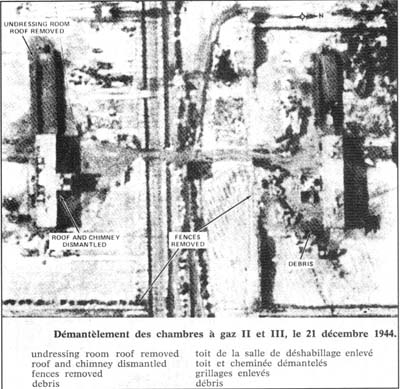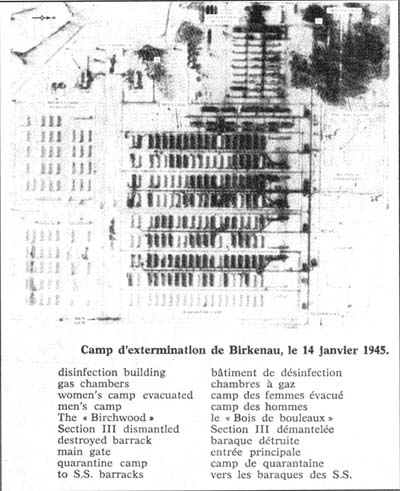|
|
 |
 |
AUSCHWITZ:
Technique
and Operation
of
the Gas Chambers © | |
|
| |
 |
Back |
 |
Contents |
Page 260 |
 |
Home
Page |
Forward |
 |
| |
| statements to the author. A group of Dr
Mengele’s twins, to which Mr Klein and his brother belonged, was
ordered by the SS to take cans pf inflammable material and
explosives into Krematorium III, then having left the building the
twins sought safety in a drainage ditch, from where they watched the
explosion) or according to Danuta Czech’s “Calendar”,
towards late afternoon. |
| |
AFTER THE WAR: RUINS,
MONUMENTS AND EXCAVATIONS |
| |
The Soviet troops who liberated Birkenau on
27th January 1945 between 2 and 3 o’clock in the afternoon found
three Krematorien in ruins, inaccessible because of the rubble. The
Soviet investigation commission does not seem to have touched those
of Krematorien II and III, but left immediately. The fact is that
the Soviet Commission had seen that while in the case of Krematorien
II and III the SS had dynamited almost entirely dismantled
carcasses, the situation was different with Kr V, where the SS had
blown up the COMPLETE BUILDING one night (between 22 and 26 January,
the exact date is not known). As no incineration furnace remained in
the camp (those of Krematorien I, II, III and IV having been
dismantled earlier), it was hoped that that of Kr V would be found
not too badly damaged in the ruins of the building [like the five
furnaces built by Messr H Kori at KL Majdanek, which had remained
intact despite the fact that the SS had burned the Krematorium in
July 1944.]. However, the SS had placed a lot of explosive in the
muffles of Kr V, so that when the rubble was cleared, virtually
nothing remained of the big 8-muffle furnace but the twisted metal
frame. For reasons of safety and for investigation purposes, the
ruins of Krematorium II [Documents 93, 94, 95, 96 and 97]
were cleared of rubble shortly afterwards in order to give access
and so that the Polish Commission (which had taken over from the
Soviet Commission) could understand its arrangement and undertake
research. The same was done with Krematorium III [Document
72], where the demolition work was less advanced than in the
case of Kr II. At this time, and for a period of several months,
nobody was allowed to visit the Krematorium areas and the entrance
to Birkenau was even guarded by the militia. Certain revisionists
have presented this measure as being intended to allow the ruins of
the Krematorien to be arranged to make them fit official history. A
claim all the more contemptible when one knows the real reason,
which was to protect the Krematorium sites from scavengers, to
prevent (in actual fact to unsuccessfully try to limit the damage)
the local population from digging for “Jewish gold,” which they
started to do immediately after the Liberation. This ignoble
treasure hunt was crowned with success for some Poles, but had the
disastrous consequence of destroying virtually all the manuscripts,
letters, photographs and other evidence concerning the criminal
activity of the Krematorien that had been buried at such risk by
members of the Sonderkommando.
Fortunately for the
Polish Commission, the Auschwitz main camp was almost intact, and
much material having belonged to the victims of the extermination
were found there [readers who have seen the Soviet film on the
Liberation of the camp will certainly remember the scene in which
the heaps of cylindrical paper sacks of about 20 kg stuffed full of
women's hair were presented]. The buildings, even the roof spaces,
were chock-a-block with the most varied and surprising |
|
 |
Document
91 |
|
| Document 92 |
 |
|
| Note: The descriptions of
Documents 93, 94, 95, 96 and 97 appearing on page 260 of the
original book have been transferred to page 261 of this electronic
version for ease in reading. The
original layout can be viewed by clicking on the thumbnail image at
the top of this
page. | |
| |
AUSCHWITZ:
Technique
and operation
of the gas chambers
Jean-Claude Pressac
© 1989, The
Beate Klarsfeld Foundation |
 |
Back |
Page 260 |
Forward |
 |
|

